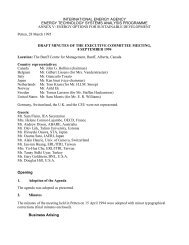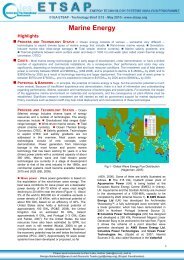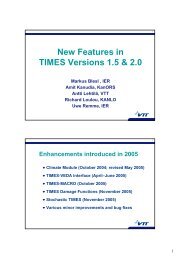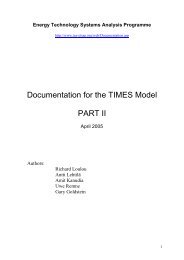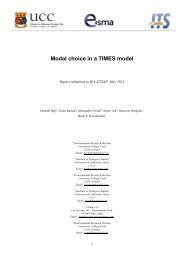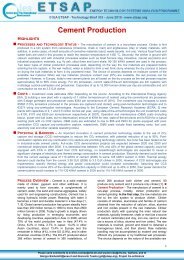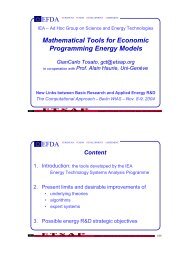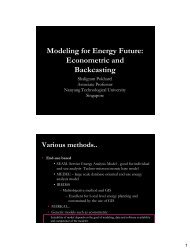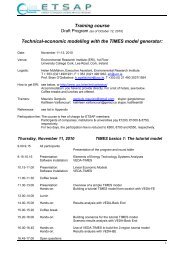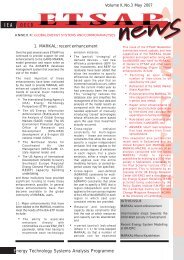Documentation for the MARKAL Family of Models - iea-etsap
Documentation for the MARKAL Family of Models - iea-etsap
Documentation for the MARKAL Family of Models - iea-etsap
Create successful ePaper yourself
Turn your PDF publications into a flip-book with our unique Google optimized e-Paper software.
4.4 Appendix A: <strong>the</strong> Demand Decoupling Factor (DDF) Utility 102<br />
This Demand Decoupling Factor (DDF) utility can be used to setup <strong>the</strong> <strong>MARKAL</strong>-<br />
MACRO reference scenario which matches both <strong>the</strong> user specified GDP growth rates and<br />
<strong>the</strong> demand levels <strong>of</strong> each demand category. This utility has been named DDFNEW.<br />
The DDFNEW utility will generate <strong>the</strong> demand decoupling factors and reference prices<br />
<strong>of</strong> each demand category, <strong>the</strong> potential GDP growth rates and <strong>the</strong> initial energy system<br />
cost needed by <strong>MARKAL</strong>-MACRO database. That is <strong>the</strong> DDFNEW utility will generate<br />
tables DDF and DDAT, parameter GROWV, and EC0 <strong>of</strong> table CONSTANT, which will<br />
match <strong>the</strong> projected GDP growth rates and demands <strong>of</strong> each demand category.<br />
The procedure <strong>for</strong> setting up and running <strong>the</strong> utility is briefly described here.<br />
Procedure<br />
1. Modifications needed <strong>for</strong> <strong>MARKAL</strong> database:<br />
a) Set up <strong>the</strong> demands <strong>of</strong> each demand category to be <strong>the</strong> projected demands<br />
(DEMAND (T) in table DM(DM)).<br />
b) In table CONSTANT, add <strong>the</strong> following data:<br />
i. DIFFDMDS: = 1 <strong>for</strong> using differential costing in MM run;<br />
ii. DEPR: The depreciation rate on capital (in percent);<br />
iii. ESUB: The elasticity <strong>of</strong> substitution;<br />
iv. KGDP: The capital-GDP ratio in <strong>the</strong> 1st period;<br />
v. GDP0: GDP in <strong>the</strong> 1st period (in billion US$), and<br />
vi. EXPF, QFAC: Parameters associated with <strong>the</strong> quadratic penalty<br />
function on excessively rapid growth, if used in MM.<br />
2. Generate and run <strong>the</strong> <strong>MARKAL</strong> BASE scenario, called in <strong>the</strong> write-up<br />
(but you can use any name you’d like)<br />
3. Check table T11 in .ANT to make sure that <strong>the</strong> shadow price <strong>of</strong> each<br />
demand category in 1st time period is nonzero. If shadow price <strong>of</strong> a demand category<br />
is zero, modify <strong>the</strong> database so that total lower bound (BOUNDLO) or fixed bound<br />
(BOUNDFX) <strong>of</strong> capacities <strong>of</strong> demand technologies related to that demand category is<br />
a little bit smaller than that required by <strong>the</strong> demand in <strong>the</strong> 1st time period. The<br />
demand satisfied by a given capacity is equal to <strong>the</strong> capacity times <strong>the</strong> utilization<br />
factor (CF) and <strong>the</strong> capacity unit factor (CAPUNIT). Rerun <strong>MARKAL</strong> case until all<br />
shadow prices <strong>of</strong> demand categories are non-zero at <strong>the</strong> 1st time period. If any <strong>of</strong> <strong>the</strong><br />
shadow prices is zero, <strong>the</strong> DDFNEW utility will give ERROR message.<br />
102 Originally written by Yu-Hua Chu and Gary Goldstein. Modified by Socrates Kypreos <strong>for</strong> matching M-<br />
M demands with externally determined demand levels.<br />
413




